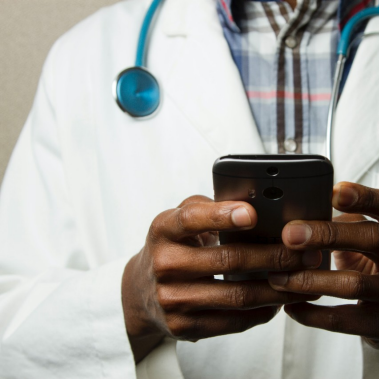Digital technologies are transforming healthcare, just as they have reshaped many other industries. As these technologies further advance and converge, they make new use cases feasible – applications that can improve health at individual and societal levels, across access, quality, and cost dimensions.
The exhibit below explores some ways in which selected enabling technologies might transform many aspects of healthcare in different settings and geographies. A range of stakeholders stand to benefit from this revolution, including patients / consumers, carers, healthcare providers, insurers, employers, pharmaceutical and medical device companies.
Digital technologies also bring risks, which are explored in other articles in the MMC Digital Health Compendium.
Technology convergence is transforming healthcare
Automated triage
Accelerated drug development
Personalized drugs and devices
Proactive prevention and early detection
Simulated training and planning
Supply chain optimization
Remote surgery
Crisis response
Artificial
Intelligence
3D printing
Augmented Reality (AR) and Virtual Reality (VR)
Edge computing
Sensors & the Internet of Things (IoT)
Fifth generation mobile network (5G)
Drones
Robotics
Automated Triage
Rapidly advancing deep learning algorithms can read and interpret images quickly and consistently, and can help radiologists and pathologists prioritize cases for faster diagnosis and with fewer errors. Symptom checkers are another increasingly popular application, offering potential diagnoses, guidance on next steps, and reassurance to patients / consumers.
Accelerated drug development
Machine learning is helping researchers find new disease targets, identify promising new drug candidates, and find new uses for existing drugs. 3D printing could further speed up clinical development by facilitating trials of multiple variants of drugs for different sub-populations. By cutting R&D costs and timelines, digital technologies can boost pharma innovation, improve patients’ health and quality of life, and lower healthcare costs for insurers, employers, and governments.
Artificial Intelligence
An umbrella term for algorithms designed to learn iteratively from large data sets and feedback, to perform a given task better over time. Sub-fields include machine learning (algorithms that learn autonomously from experience), natural language processing, speech recognition, computer vision etc.
3D printing
A form of additive manufacturing that allows an object or medical device to be created layer by layer from a digital file.
Personalized drugs and devices
3D printing has the potential to create customized medications and devices that suit individual patients or population segments, increasing convenience and compliance – for example, tailored size, structure, or dosage; extended-release tablets that reduce dosing frequency; tailored ‘polypills’ that combine all of a patient’s medicines in one pill; and ingestible electronic pills that can image organ structures and/or deliver and monitor medication.
Augmented Reality (AR) and Virtual Reality (VR)
Computer-generated simulations that enhance or replace a real-life environment. AR adds digital elements to a real-life view; VR creates immersive artificial environments.
Proactive prevention and early detection
Wearable and ambient sensors can continuously monitor many health and activity indicators. These devices can help patients and consumers spot early signs of disease and manage chronic conditions; they can also prevent and detect falls to enable elderly users to live independently.
Simulated training and planning
Using realistic 3D models of human tissue and disease scenarios, AR/VR applications can help physicians practice surgical techniques, and plan and guide procedures to reduce surgical time, error, and cost. Therapeutic applications of virtual reality include immersive, interactive simulations for pain management, rehabilitation (for example, stroke recovery), and smoking cessation.
Edge computing
A distributed approach that minimizes latency by storing and processing data closer to where it is produced (the edge), rather than at a centralized location.
Supply chain optimization
A network of sensors and edge computing can help secure pharmaceutical supply chains by tracking and verifying products, and and ensure drug safety by monitoring and controlling temperatures in real time during transport and storage
Sensors & the Internet of Things (IoT)
Sensors are devices used to detect and measure various indicators such as vital signs, temperature, position, or speed. IoT is a group of sensors and devices that connect to one another and exchange information.
Fifth generation mobile network (5G)
A new wireless standard of mobile networks characterized by high speed, increased reliability, and ultra-low latency. From more immersive experiences to greater dependability of connected devices, 5G could power innovations that are not viable under existing mobile networks.
Remote surgery
Assisted by surgical robots operating over a 5G network, physicians can perform some surgical procedures on far-off patients with accuracy, precision, and few complications. Telesurgery allows healthcare providers to bring a broader range and higher quality of services to rural and poorer populations, facilitating timely care, better outcomes, and reduced disparities for patients, as well as lower costs for payers.
Robotics
Healthcare robots perform or assist humans with complex tasks in varied settings including hospitals, elderly care, pharma supply chains, and homes and communities.
Drones
Unmanned aerial vehicles that can deliver products, take aerial photographs, inspect infrastructure, etc.
Crisis response
Drones already transport blood and medicines to hospitals in remote regions. The same technology can deliver critical supplies like drugs, vaccines, and protective equipment to people during disasters and disease outbreaks, particularly in poorer and remote places with weak health infrastructure.

